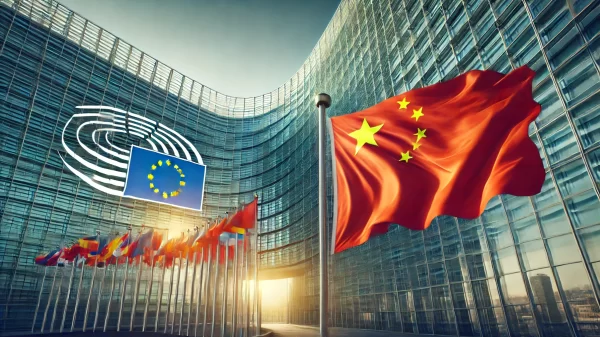Germany’s environment minister Robert Habeck has admitted that the country will likely miss its carbon emissions targets in the coming two years, a troubling sign for Europe’s largest economy. Indeed, Europe evidently needs to do more to accelerate the continent’s green transition, with EU scientists announcing on Monday that 2021, the fifth-hottest year on record, featured Europe’s hottest-ever summer.
According to the Intergovernmental Panel on Climate Change (IPCC), the possibility of limiting global warming to 1.5°C or even 2°C will soon be beyond reach unless policymakers can deliver large-scale reductions in greenhouse gas emissions. The consequences of warming exceeding these tipping points, climate scientists warn, will be catastrophic, from substantial sea level rises to an increasing number of destructive megastorms.
It’s worrying, then, that greenhouse gas emissions across the EU are inching up again after a brief reprieve wrought by the COVID-19 pandemic. The EU has made substantial efforts so far to curb emissions, but as the European Commission itself has acknowledged, these measures are insufficient, with the energy sector doing most of the heavy lifting in the race to carbon neutrality. In fact, the bulk of the bloc’s emissions come from four sectors—building, industry, transport and agriculture—the latter two of which have seen increased emissions over the past decade.
This means that despite a concerted push for renewable energy, an unfettered return to the carbon-intensive economic activity that prevailed before the pandemic will undoubtedly stymy further progress toward climate goals. As it stands, the EU will miss its 2030 emissions targets by 21 years unless more ambitious policies are enacted across the bloc.
Stressing the importance of reuse
Fortunately, there are a number of underutilized avenues for reducing emissions which Brussels should tap into. One is the waste sector, where the EU needs to do much more to promote reuse alongside recycling.
Consumerism has, without a doubt, been the champion of European economic growth over the past century. The corresponding environmental impact of packaging, however, is difficult to comprehend: the Great Pacific Garbage Patch of floating plastic is three times larger than France, the average plastic bag is used for just 15 minutes, and the global oil and gas industry is determined to keep demand for single-use plastic as high as possible.
As part of the EU’s New Green Deal, policymakers appear to be catching on to the need for comprehensive reuse infrastructure through plans such as the introduction of a “Digital Product Passport”, intended to gather information about the composition of goods to increase their chances of being reused and recycled as they pass through the European economy.
Still, amidst an environmental movement that has long championed the benefits of recycling, European decisionmakers need to do more to promote reuse, which allows the energy needed to extract, transport and process materials to be kept to an absolute minimum. One concrete step which could yield significant benefits would be an EU-wide harmonization of what is considered “waste” and what can sustainably recovered and reused.
Under the current system, many EU countries fail to adequately distinguish between consumer packaging and industrial packaging. This unfortunately leads to substantial amounts of commonly used industrial packaging, such as steel and plastic drums as well as intermediate bulk containers (IBCs), being written off prematurely as waste rather than cleaned and reconditioned, a process which could extend these products’ usable lifetime by years and yield substantial emissions reductions.
Room for improvement in building sector
Another window of opportunity is the building sector, responsible for some 25 percent of Europe’s greenhouse gas emissions and 40 percent of energy use, with many heated by fossil fuels. Last month, the European Commission mooted new rules that would require buildings to abide by energy-efficiency standards and emit no on-site carbon emissions from fossil fuels by 2030.
“The worst-performing buildings in the EU consume many times more energy as new or properly renovated ones,” explained EU energy commissioner Kadri Simson. “Renovation reduces both the energy footprint of buildings and the energy costs for households, while also boosting economic activity and job creation.”
Under the new proposal, all buildings in the EU with the worst energy rating, a “G” energy performance certificate, must be renovated to a higher grade by 2030. Homes with an F-grade rating must be renovated by 2033, meaning millions of buildings will soon need green renovating through the use of insulation or more efficient heating systems.
Still, experts have warned that these new rules do not go far enough to encourage essential green renovations. According to some, the setting of minimum grades is essential to get renovations underway on the absolute worst-performing buildings, but Brussels has so far missed an opportunity to incentivize deeper renovations to bring buildings into the best performing A, B or C grades, a shift which could yield important emissions reductions.
Other critics have called for a wider focus. According to the European Academies’ Science Advisory Council (EASAC), renovating buildings to reduce energy consumption makes little sense if the process of renovation itself is carbon intensive. If construction materials and components must be transported over long distances, for example, the cumulative greenhouse gas emissions of newly renovated buildings may ultimately be an own goal for policymakers. Instead, the climate impact of each building should be assessed on a more holistic basis, taking into account its cumulative greenhouse gas emissions including any emissions produced by works on the building.
With less than a decade remaining before the window to cap global warming at 1.5°C has closed for good, European policymakers need to think outside the box. As pundits have warned, the greening of the energy sector has yielded substantial emissions reductions up until now, but “the next round of emissions cuts will be even harder”. In order to pull it off, Brussels will need to increasingly look outside the box and tap into areas with underutilized emissions-reduction potential, such as the waste and building sectors.
Share this article:



























